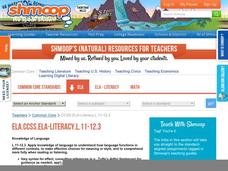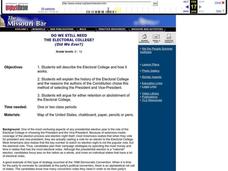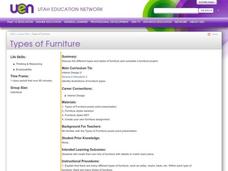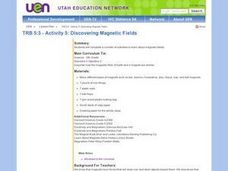Curated OER
Blowing and Flowing
Fifth graders compare and evaluate the rate of erosion from water and wind on three type of landscape: bare land, land with sparse vegetation, and land covered by dense vegetation.
Curated OER
Government: The Power of Persuasion
Students are able to define and identify a type of interest group. They are able to describe some strategies used by interest group. Students are able to identify the postive and negative aspects of interest groups.
Curated OER
Government Lesson Plan 16
Students identify different economic systems, compare economic systems by determining how the three basic economic questions are answered in each, and explain concept of mixed economies.
Curated OER
We Choose Our Own
In this governments worksheet, students fill in a chart for how leaders rule in a monarchy, dictatorship, and republic. Students also complete 3 short answer questions.
Shmoop
ELA.CCSS.ELA-Literacy.L.11-12.3
Tired of simple sentences? Bored by brief sentences? Plagued by boring sentences? Enrich your life and the writing of your pupils by modeling how to combine sentences to create more varied syntax. Groups then find a number of ways to...
School Improvement in Maryland
Political Systems: Advantages and Disadvantages
Every political system has advantages and disadvantages. To gain an understanding of these differences, groups investigate the political system of another country—oligarchy, monarchy, dictatorship, parliamentary—and prepare a...
Curated OER
Identifying Career Interests in the Volunteer and Government Sectors
Here is a great way to give your class a real-life job experience, while also serving the community. They explore a variety of volunteer opportunities to build career interests, gain work experience, and help their community grow. This...
C-SPAN
Primary and Secondary Sources: Trailblazers in Congress
Trailblazers forge the path into uncharted territory, they establish a precedent for others to follow. Young historians research trailblazers in Congress using primary and secondary sources to profile outliers that changed the face of...
Curated OER
Why We Chose Our Constitution
Students examine the American plan for government. In this American government lesson, students examine selected Internet websites regarding the Magna Carta, the Articles of Confederation, and the Constitution.
Curated OER
"All Men Are Created Equal"
Students identify the premise of the United States' Democracy. They list the major elements of the document. Students reflect on the inequalities of the late 1700's premise of other units. They complete a KWL chart about the Declaration...
Curated OER
Types of Societies
Young scholars compare and contrast the societies of India and the United States by creating a chart. In groups, they give examples of each type of classification. They present their material to the class while identifying the role of...
Curated OER
Do We Still Need the Electoral College?
One of the most confusing aspects of any presidential election year is the role of the Electoral College. Learners read a bit about how the Electoral College works and then they hold a mock election in their classroom. They'll redraw a...
Curated OER
Types of Furniture
Students discuss the different types and styles of furniture and complete a furniture project. They create their own line of furniture with details to match each piece. They explain that there are many different types of furniture,...
Curated OER
Personal Body Types
High schoolers are introduced to the four main body types. Individually, they label their own body type and disover which styles would be most flattering to their figure. To end the lesson, they design an outfit for themselves and...
School Improvement in Maryland
Executive Order
After reading information about Executive Order #9066, class members assume the voice of an 18 year-old Japanese-American born in California and placed in an internment camp. Individuals then craft a letter to President Roosevelt...
School Improvement in Maryland
Court Proceedings Civil Cases
What's the difference between civil and criminal law? How do the court proceedings differ in these two types of trials? How do the standards of proof differ? Why do these differences exist? As part of their examination of the...
Curated OER
State of Affairs
Students examine the various roles and duties of state government officials and offices to create an Informative Guide to Our State's Government. They explore the changing relationship between governor and lieutenant governor in New York.
Stanford University
Great Society
Students explore the Great Society. For this U.S. history and government lesson, students view the video "The Great Society," identify the major points of the speech, and compare and contrast the content with The New Deal.
Curated OER
Discovering Magnetic Fields
Fifth graders examine the different types of magnets (bar, horseshoe, disc, ball, etc.) and experiment with the magnets and iron filings to discover the magnetic fields of each type of magnet.
Curated OER
Perks and Perils
Students research the life of the first family. In this U.S. Government activity, students take a White House quiz, read an article about the first family and write in their journals about a typical day in their lives versus what a day...
Curated OER
Government and Community Resources
Young scholars explore how to communicate using past tense and present perfect tense verbs. They discuss words related to postal activities and the procedures to follow when mailing letters and packages, registering mail, and buying...
Curated OER
iCivics: Court Quest
Students explore the responsibilities of the Supreme Court. In this judicial branch lesson, students play an online game that requires them to respond to questions regarding the Supreme Court's responsibilities.
Curated OER
What a Relief!
How are disasters addressed by the Federal Government? This New York Times lesson plan, based on the article "Disaster Aid: The Mix of Mercy and Politics," prompts middle schoolers to discuss the idea of using a disaster declaration as a...
Curated OER
Get Educated During Childhood Obesity Awareness Month
Twenty-three million American kids are overweight and at risk for type 2 diabetes, high blood pressure, heart disease, and stroke during childhood.

























